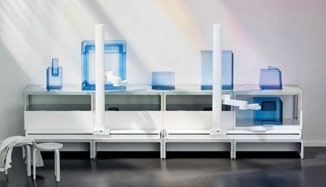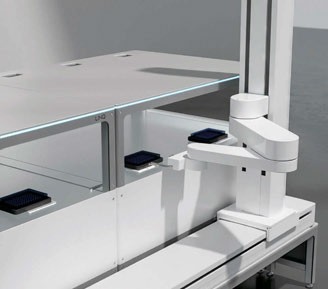Automating the Lab of the Future
Automation holds the key to unlocking the Lab of the Future
Lab layouts, until the introduction of automation, had seen little change in decades. However, the increased usage of hardware and software lab automation has reduced repetitive manual tasks and drastically increased the walkaway time involved in experiments
Russell Green at Automata
Lab layouts have seen little change in decades − from benches following the same design and scientists heavily engaged in manual workflows, to plate reformatting and barcoding tubes. Much of the laboratory automation to date has focused on automating highly specialised benchtop instruments like liquid handlers or plate readers. While this has relieved scientists of some repetitive manual tasks, like pipetting, they still spend hours moving samples between instruments. This is time that could be spent focusing on designing new experiments and analysing important data. With the adoption of fully automated processes, scientists can work collaboratively across the world and scale the amount of experiments running in a lab (or across multiple labs) all without compromising accuracy or repeatability. The result? Efficiently run labs that gift time back to scientists so they can spend time working on valuable tasks that ultimately lead to faster discoveries.
The power of an automated lab bench
With the application of robotics, entire workflows can be connected, automated and optimised for productivity by integrating multiple pieces of equipment in an end-to-end workflow. In addition to increasing the throughput of a lab, fully automated workflows ensure accurate results. By allowing every piece of equipment to operate concurrently and carry out a variety of different processes, it becomes possible to achieve much closer to 100% capacity compared to manual processes, while maintaining accuracy.

Reimagining lab workflows with software automation
Software also plays a key role in effective lab automation. For example, a digital platform can replicate how a lab’s workflow will run, allowing scientists to visualise, test and, where necessary, adapt workflows before implementing them in real-life experiments. This means scientists can be confident in the correct execution of assays without ever having to make hardware adjustments. Consequently, less time is spent manually correcting workflows, freeing up more time for running effective experiments and generating valuable data.
By integrating the digital and physical workflow, it becomes possible to monitor and manage experiments remotely. Previously, scientists were constrained to the lab for large parts of the day, monitoring the progress of experiment. However, with lab automation, they can be confident that the scientific process is always happening correctly, regaining the time previously spent keeping a watchful eye and allocating it to higher value tasks. Software can also help harvest data from experiments and automatically upload them to a digital platform, streamlining the analysis process and minimising the risk of manual errors. Given that many labs still rely on manual processes, there is a risk of samples being mislabelled, data recorded incorrectly and siloed workflows due to poor visibility of results. These factors can impede or derail scientific research, incurring costs in both money and time.
Future-proofing with flexibility
Every lab is unique, with different goals ranging from gene editing to the development of cell-cultured meats and materials. The purpose and goals of every lab are constantly changing too. Therefore, automation cannot take a one-size-fits-all approach; it must be flexible and customisable to accommodate every workflow.

This flexibility becomes especially important in the current climate, when the demand for lab space in the UK is at an all-time high. We are witnessing the conversion of spaces like unused retail stores and offices into labs spaces that weren’t originally designed to include lab equipment.1 The more flexible the hardware, the more effective these repurposed spaces can be. In order to achieve this flexibility and future-proof labs, a modular approach to equipment is key. This will allow for the addition of more benches to expand processes and safeguard the investments of lab science organisations. Integrated software can also play a pivotal role in this regard. For example, when the needs of a lab evolve, hardware can be swapped in and out to seamlessly deliver one unified ecosystem.
Achieving consistency while scaling
For larger organisations with labs spread across the world, it is crucial to ensure consistent application of workflows to achieve replicable and repeatable results. While the physical lab spaces may vary across locations, cloud-based lab automation software ensures that the workflows running in them and the data collected is identical in every disparate lab. As well as anywhere, using the Cloud makes it possible to run, monitor and even modify experiments at any time, meaning workflows don’t have to be manually stopped and started from within the lab, granting scientists far more freedom in managing their working week. This flexibility becomes particularly valuable when working with highly demanding samples, like growing cells. Scientists no longer need to be physically present in the lab during late hours or weekends, as they can remotely monitor the status of cells and customise experiments to start at the most opportune time. This ensures optimal attention and care for the samples without compromising scientists’ work-life balance. By utilising cloud-based lab automation and remote monitoring capabilities, organisations can streamline operations, increase flexibility and enhance the efficiency of their scientific research across multiple locations.

Closing thoughts
Automation in the lab has already made significant strides in recent years, but scientists still find themselves spending too much time on manual processes. As a result, the ability to scale processes and output is hampered and the risk of manual errors in the lab grows. By harnessing the power of integrated hardware and software, scientists can allocate their time to designing new experiments and drawing conclusions from automatically harvested data whilst simultaneously ensuring the smooth operation of ongoing experiments. This represents the Lab of the Future and with automation it can be achieved.
References
1. Visit: bbc.co.uk/news/uk-england-somerset-63838257

Russell Green is director of Product Growth for Cell Culture at Automata. Russell was previously the head of Partnerships and senior product manager at Synthace and senior manager field projects at Beckman Coulter Life Sciences. He has been at the forefront of developing lab solutions that optimise workflows, enhance data accuracy and accelerate scientific discovery. Russell’s expertise lies in harnessing automation to reshape research process, enabling scientists to achieve greater efficiency, reproducibility and scalability in their experiments. Russell holds a Bachelor's degree in Biochemistry and a PhD in Biochemistry and Molecular Biology.